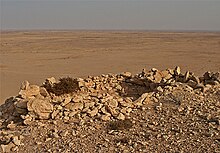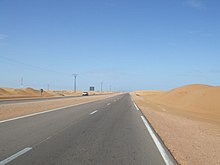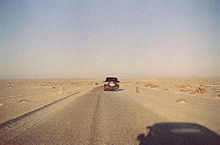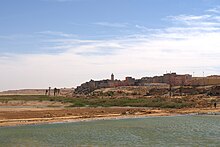| WARNING: The area starting at the Berm and extending for 30–50 kilometres (19–31 mi) west is littered with land mines. Many governments recommend against travel near the Berm or to the east of it.
The United States Department of State no longer issues separate travel advice for Western Sahara due to the formal recognition by the United States of Morocco's claims over the disputed region in 2020. | |
Government travel advisories
| |
| (Information last updated 25 Jul 2023) |
Western Sahara is an area on the west coast of North Africa. A former Spanish colony, its governance is disputed between Morocco and the Sahrawi Arab Democratic Republic (SADR). After a UN-brokered ceasefire in 1991 ended a war between the two, Morocco ended up de facto controlling about 80% (and almost the entire coast) of the disputed area, with SADR controlling the region around the Mauritanian and Algerian borders. The Berm is the de facto border between the two administrations, and the areas around it are full of landmines.
|
None of the content in this guide should be taken as a political endorsement of claims by either side in the dispute over the sovereignty of these territories. |
Cities
[edit]Under Moroccan administration
[edit]Under SADR administration
[edit]Under Mauritanian temporary administration
[edit]Other destinations
[edit]For those interested in sight-seeing, there are few opportunities to see wildlife or natural formations other than the dunes. The area controlled by the Sahrawi Arab Democratic Republic (SADR)—known as the Free Zone or Liberated Territories—is of interest to those interested in the political conflict.
Understand
[edit]While there is a long coastline, much of it is rocky and not fit for beaches or travel. Large-scale fishing and ports are at Ad Dakhla. Much of the territory is arid desert.

The area to the immediate east of the sand wall (also known as "the Berm") was peppered by land mines and should be considered off-limits to any traveler: the territory had one of the highest concentrations of land mines in the world and even where warning signs were posted, most are gone due to the weather. The SADR destroyed its landmines several years ago but some may remain. The Moroccan side of the wall still contains thousands of mines and is extremely dangerous. Furthermore, the SADR-controlled Free Zone has almost no roads, so profound navigation experience and a 4×4 with high ground clearance is required. The gates in the berm, which can be used by UN patrols, are not open to regular travelers.
The political situation has been in a stalemate for decades. Breakdowns in negotiations have led to threats to break the ceasefire, and indeed, there has been some fighting in the 2020s.
SADR has been recognized by only around 46 countries and has control over only a largely uninhabited eastern slice of territory. Explicit support for the Moroccan view is also scarce, with the United States being the first country to recognize Moroccan sovereignty over the region in 2020 (as part of a deal wherein Morocco and Israel would normalize relations in exchange for US recognition of Moroccan claims in the region).
History
[edit]Under Spanish rule, as Spanish Sahara, the territory was divided by Spain into two administrative regions: the northern strip, known as Saguia el-Hamra, and the southern two-thirds, named Río de Oro.

Morocco occupied and annexed the northern two-thirds of Spanish Sahara in 1976, while the rest was annexed by Mauritania; the Polisario declared the Sahrawi Arab Democratic Republic (SADR). When Mauritania withdrew in 1979, Morocco annexed the southern portion of the territory. A guerrilla war with the Polisario Front liberation movement contesting Rabat's sovereignty ended in a 1991 cease-fire. A referendum on final status has been repeatedly postponed; a sticking point regarding any potential referendum is who would get to vote. In 2020, the United States agreed to formally back Morocco's claims to the region in return for Morocco normalizing relations with Israel.
Political situation on the Moroccan side
[edit]There has been unrest and protests in the Morocco-controlled area, met harshly by police. Where popular sympathies lie is unclear.
The Moroccan name for Western Sahara is "Southern Provinces"; calling it "Western Sahara" can bring your political position into question, and people who don't share the Moroccan government's position can be deported and banned from re-entering Western Sahara. The safest and most hassle-free way of traveling in this area is to ignore politics completely.
Unlike in other parts of Morocco, checkpoints on the road are to be taken very seriously: always come to a full stop unless explicitly motioned to move on. Travel plans communicated at the last checkpoint should not be changed spontaneously: travelers are sometimes tracked pretty well, and if you show up in a different place than the one on your itinerary, questions may be asked.
Moroccan officials are very wary of journalists and humanitarian aid workers, due to a perceived interference with what they consider purely Moroccan matters. It is strongly advised that you not mention a profession even remotely related to those. This is also true for the immigration forms filled out when entering Morocco — officials at every checkpoint can retrieve that data via phone and sometimes do.
People
[edit]Western Sahara's inhabitants, known as Sahrawis, are ethnically Arab and speak the Hassānīya dialect of Arabic. They are Bedouins and share many cultural similarities with other Bedouins. They are hospitable and known for their elaborate tea ceremonies.
Economy
[edit]Western Sahara depends on pastoral nomadism, fishing, and phosphate mining as the principal sources of income for the population. The territory lacks sufficient rainfall for sustainable agricultural production, and most of the food for the urban population must be imported. Virtually all trade and other economic activities are controlled by the Moroccan government. Moroccan energy interests in 2001 signed contracts to explore for oil off the coast of Western Sahara, a move that has angered Polisario and international observers. Incomes and standards of living in Western Sahara are substantially below the Moroccan level. Basic food items and gas are subsidized by the Moroccan government.
Climate
[edit]Western Sahara is a hot, dry desert; consequently, rain is rare, but flash floods occasionally occur. Cold offshore air currents produce fog and heavy dew. There is very little water in the ground. This coupled with a lack of water vapor in the air, which in other regions acts as a greenhouse gas, allows daytime heat to be lost very rapidly into space via infrared radiation. The result is harsh cold nights, despite the very high daytime temperatures. In comparison with the Central Sahara, though, the Western Sahara has more moisture in the air, and a lower annual temperature range due to proximity to the Atlantic Ocean. Along most of the coastline, thick fog can form in the early morning hours and greatly reduce visibility until noon.
Landscapes
[edit]Mostly low, flat desert, with large areas of rocky or sandy surfaces rising to small mountains in south and northeast. Low-lying sand dunes cover the territory.
If you are traveling overland, you will find no border formalities between Morocco and Western Sahara. Your passport may be asked for at the many checkpoints on the road south, but will not be stamped, as the Moroccan authorities regard the Western Sahara as part of Morocco.
Get in
[edit]
The vast majority of Western Sahara is administered by Morocco, which considers it an integral part of its territory, so the same entry conditions apply as for the rest of Morocco. However, independent travel in the region is restricted. While crossing through Western Sahara while traveling overland between Morocco and Mauritania is usually OK, some travelers have been turned back when trying to enter, especially during periods of political strife. At any time, travelers can be turned back if they are suspected to have any interest in the political or humanitarian situation: any hint at journalistic activities or anything even remotely connected (like working as cameraperson for even an advertisement agency) should be avoided.
Official entry requirements for SADR-controlled areas are unclear, but in practice, the area is entirely off-limits to visitors: you cannot legally cross the heavily guarded and mined berm from the Moroccan-controlled side, and the land border with Algeria, which used to be the entry route, is closed. There are no legal border crossings from Mauritania into SADR-controlled territory, either.
By plane
[edit]- From Spain, the Canary Islands and various cities in Morocco: Laayoune, Hassan I Airport (EUN IATA)
- From Agadir, Casablanca and seasonally from the Canary Islands: Dakhla Airport (VIL IATA)
- Τhe Moroccan National Tourism Office (ONMT) decided to open the Dakhla-Paris route with Royal Air Maroc, as of early 2021.
Even for domestic flights, passport controls are stricter than in the rest of Morocco.
By bus
[edit]Buses connect all larger cities and will drop passengers anywhere along the road when asked.
By boat
[edit]While there has been discussion or restoring the ferry to Tarfaya from the Canary Islands, as of June 2019, it seemed unlikely.
By car
[edit]See also the #Get around section below.
- From the north, along the coast: From Agadir one can just drive down the RN1 through Tiznit, Guelmim, Tan-Tan, passing Tarfaya 30 km (19 mi) east, through Akhfenir, Laayoune, Boujdour, Dakhla all the way to Mauritania.
- From the north, through the desert: The road from Assa via Zag to Al-Mahbes apparently has been closed for years, but was open between Assa and Zag as of early 2014. Continuing onwards to Al-Mahbes was denied by local authorities with reference to the frequent military operations, landmines and general security concerns. Al-Mahbes is relatively close to Tindouf, the Polisario's headquarter and the refugee camps, which possibly renders the region sensitive in the view of the Moroccan military. Moreover, this region is rumored to be possibly part of the operational area of Al-Qaeda in Magreb.

- From the south: Entering Western-Sahara from the south (Mauritania) involves passing through a few kilometers of no-man's land, which is notorious for its landmines, bandits, and false guides offering to guide you through the strip. Only attempt this passage in full daylight and with either a reliable guide, or much more practical, in a convoy; just talk to some truck drivers at the border. Do not be misled by the old tarmac road which you will cross: this is the so-called "Spanish Road", which dates back to the era of Spanish Sahara (before 1975) and in both directions only leads to impassable sand dunes and minefields. Only a few meters of this road are still in use today, which are close to the Mauritanian Border Post. Do not venture on this road any further than this. Deadly incidents have continued to occur as result of falsely interpreting the Spanish Road as the right track.
By bike
[edit]There is a bike route by the coast, from Guelmin in Morocco via Western Sahara and Mauritania to Saint Louis in Senegal. See Cycling the Western Sahara.
Get around
[edit]By car
[edit]Traveling by car is probably one of the most convenient means of transport in Western Sahara, as public transport restricts one to larger settlements. Though there are some precautions one should take:
- Always refuel before any longer stretch on the road. That larger town on your map might turn out to be a small village without a gas station. Especially south of Tan-Tan, settlements are few and far between.
- The road's condition changes from "awesome" to "abysmal", often without warning and sometimes every few kilometers. Don't follow the guy who overtakes you with 150 km/h (93 mph)—you might meet him later anyway, with a broken axle, a good 100 m off the road. Don't even trust your own experience on a road—a single night of rain can turn a great road into a terrible one.
- When going off-road, either know that the area is free of mines or have a reliable guide. Follow existing tracks where possible.
- Take a mobile with you, it will work in almost all areas and it will make life easier when the car breaks down.
- And the usual desert tips: bring more than enough water, something to keep you warm at night in case you have to sleep in your car.
- There are several police checkpoints along the road. Additionally to the typical controls at the entrance and exit of main villages (Laâyoune, Cape Bojador and Dakhla), there are checkpoints on the bridge over the Oued Drâa (N28º 31.862’ W10º 56.669’) just before Tan-Tan, 2km before Sidi Akhfenir (on the first cheapfuel station: N28º 05.814’ W12º 02.824’) and on the crossroad to Dakhla (N23º 53.615’ W15º 40.585’). At the crossroad, if you just want to fill out in the nearby fuel station and not want to drive all the way to Dakhla, explain that to the police which will probably let you pass more rapidly. In fact, police checkpoints are usually friendly and things can move very rapidly if you hand out a photocopied paper with the details of the travellers: name, surname, date and place of birth, address, profession, number and validity of the passport, coming from, going to, date of entry in Morocco and the Moroccan police number (a group of letters and numbers stamped usually on the last page of the passport when entering Morocco); and also of the vehicle: brand, model and license plate number. Be aware that radars for estimating speed are on the rise in Morocco, and they are no exception in Western Sahara; a typical spot for speed checking is on the southern exit of Laâyoune.
Talk
[edit]The native language of the majority is Hassaniya Arabic. It is not mutually intelligible with Standard Arabic, which is not widely spoken.
Moroccan Arabic is also widely spoken, and is the lingua franca on the streets and the workplace because of the many Moroccans residing in the country.
French is spoken by a lot of those who moved in from Morocco proper and to some degree by a lot of locals who sometimes deal with tourists.
Spanish is spoken rarely (mostly by those old enough to have learned it under Spanish occupation), English even rarer.
People are generally very patient with people they don't share a language with and are also used to communicating with their hands and feet. Also, because of a very low literacy level, writing things down does not help communication much.
See
[edit]
- The Saharan desert.
- Remnants of the Spanish colonial rule in the capital El Aaiún.
- Many beautiful, completely unspoiled beaches that sometimes go on for miles.
Do
[edit]Buy
[edit]Money
[edit]|
Exchange rates for Moroccan dirham
As of January 2024:
Exchange rates fluctuate. Current rates for these and other currencies are available from XE.com |
The official currency of the Moroccan-controlled portion is the Moroccan dirham, sometimes symbolised as "Dh", "Dhs, "DH", "درهم, or the plural form of "دراهم" or "Dhm" (ISO code: MAD). It's divided into 100 santime or centimes (c). There are 5c, 10c, 20c, 50c, 1, 2, 5 and 10 dirham coins, although coins smaller than 20c are rarely seen these days. Banknotes are available in denominations of Dh 20, 50, 100 and 200.
The SADR has also minted its own pesetas ("Pts.", ISO code: EHP). It has an official exchange rate of €1 for 166.386 Pts. Algerian dinars and Mauritanian ouguiyas circulate alongside the Sahrawi peseta in the Sahrawi refugee camps and the SADR-controlled part of Western Sahara.
Costs
[edit]Prices are lower than in Morocco, in part due to Moroccan government's subsidization policy.
Eat
[edit]With fishing being the main source of income for the local population, fish is the obvious choice: It is fresh and very cheap.
Drink
[edit]Traditional Sahrawi hospitality includes the serving of tea to all guests in one's home. The tea is really strong, even for people used to high caffeine intake.
Stay safe
[edit]Hot, dry, dust-and-sand-laden sirocco wind can occur during winter and spring; widespread harmattan haze exists 60% of time, often severely restricting visibility. There are low-level uprisings and political violence which is altogether rare, but can escalate. Occupying powers are likely to evict foreigners in such case.
The N1—and even more so the roads into the heart of the territory—are very remote roads, with facilities and settlements being easily 150–200 km (93–124 mi) away from each other. Take enough fuel (always refuel before going on the next leg, you never know what is going to happen) and enough water (several liters per person). Mobile network connection exists along N1.
Landmines and unexploded ordnance (UXO)
[edit]There was war in Western Sahara for over 15 years in the 1970s and 1980s, and as a result, the landmine and UXO situation to this day remains quite unclear, despite efforts of the Moroccan Government to improve the situation. There are landmines not only in the remote parts of the country close to berm, but all the way down main coastal road (N1) to the Mauritanian border. Google Earth clearly shows the efforts to clear minefields all along N1, which continue to this day—despite Moroccan officers tending to tell tourists that this part of the country is safe. Around the settlements (Boujdour, Ad-Dakhla, Golfe de Cintra) the situation seems to be slightly worse, possibly due their strategic significance in the war. The warning signs are sometimes so rusty that they can't be recognised anymore, but usually the combination of two small metal signs is a strong indicator.

Keep eyes open to lines of stones, cairns, staples of old tyres and similar man-made marking—they are usually meaningful! Generally, any place off the tarmac-road of N1 and off-branching tarmac roads must be considered unsafe. Car-wrecks are strong indicators—do not explore these! Strategically significant points (the various small passes, narrow valleys, elevated points, etc.) are more dangerous, but this does not mean that other places are safe. Any man-made fortifications (straight sand-walls, round sand-wall [for artillery] and any other military looking movements of ground) pose particular danger (esp. south of Ad-Dakhla, but also south of Boujdour). It might be that these were mined when being abandoned to prevent them from falling into the other party's hand, or it might be that the surroundings were mined from the beginning to protect against guerrilla attacks, but anyway the mine-cleaning patterns strongly indicate that such places were and possibly continue to be particularly dangerous. Few to no mine-clearing efforts can be observed off the N1 - that possibly means that (e.g. for lack of touristic significance) these areas continue to be mined and efforts were focussed at the immediate surrounding of N1.
The patterns of cleaning mine-fields indicate that in not all cases does the Moroccan Government seem to be aware of the location of minefields, which requires more or less random search pattern. Moreover, on Google Earth it can be seen that where minefields have previously been cleared, new clearing activities have resumed later. This again indicates that even traces of cleared minefields do not guarantee safety. This includes the surroundings of the lagoon of Ad-Dakhla, including the lands north of it.
Stay healthy
[edit]No matter whether you travel in a private car or on a bus, always take enough water for at least 24 hours to be prepared if the vehicle breaks down.
Don't touch unknown vegetation—some of the seemingly good looking fruit one can find on the road side are poisonous even when just touched (one looks like miniature water melons, another like small cucumbers).
When climbing some of the rare stone formations, be aware of scorpions. Even though extremely rare, sometimes cobras are spotted (usually after a period of a few days with hot winds blowing to the West).
The quality of tap water is variable; ask before drinking it, or just drink bottled water.
Respect
[edit]|
Ramadan
Ramadan is the 9th and holiest month in the Islamic calendar and lasts 29–30 days. Muslims fast every day for its duration and most restaurants will be closed until the fast breaks at dusk. Nothing (including water and cigarettes) is supposed to pass through the lips from dawn to sunset. Non-Muslims are exempt from this, but should still refrain from eating or drinking in public as this is considered very impolite. Working hours are decreased as well in the corporate world. Exact dates of Ramadan depend on local astronomical observations and may vary somewhat from country to country. Ramadan concludes with the festival of Eid al-Fitr, which may last several days, usually three in most countries.
If you're planning to travel to Western Sahara during Ramadan, consider reading Travelling during Ramadan. |
The culture is Islamic but not particularly strict; the form of Islam that developed among the nomad population is non-mosque-based. Political and social displays of Sahrawi nationalism are violently repressed by the Moroccan police and military.
Connect
[edit]Teleboutiques and internet cafes are not hard to find in the cities, but connection speed may vary from place to place. Most cafes, restaurants and hotels offer free wifi.



